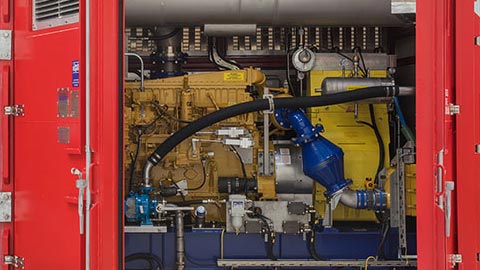Calder saves time and money
Calder saves time and money

Case Study
Pump package manufacturer uses Solid Edge to meet exacting industry standards while minimizing footprint and weight
Calder
With Siemens Digital Industries Software solution, Calder saves time and money
Minimizing weight and footprint
Weight and space become crucial factors when supplying equipment destined for a location such as an offshore oil/gas platform, especially if the overall package is the size of a house and comprises multiple sub-assemblies and tens of thousands of parts. In addition, it is essential that any design is absolutely right prior to fabrication as the special highly corrosionresistant stainless steels required for demanding and hazardous environments are very costly materials. These are just some of the challenges facing Calder Ltd., which has been providing high-quality pumping solutions since 1981.
The company serves a range of markets including energy, automotive and civil engineering. With particular expertise in designing for high-pressure, high-saline, hazardous area environments, Calder has many customers in the oil and gas sector, where design integrity and safety are paramount. Nearly half of all packages made for the offshore environment are supplied in an environmental enclosure designed to withstand an overpressure blast event.
In order to deliver high-specification products that meet the most stringent regulatory and customer requirements, Calder uses Solid Edge® software from product lifecycle management (PLM) specialist Siemens Digital Industries Software. Consultancy and support are provided by Siemens Digital Industries Software partner, Prion Cutting Edge.
Precision at an early stage
One of the key conditions for Calder is to design for ease of manufacture, assembly and maintenance yet, sometimes, the design team only has a week in which to produce an initial design concept. “What I like most about Solid Edge is that I can quickly make several models with all the major parts and compare the best options for process flow, ease of access for maintenance, footprint and cost,” says Ben Monkton, lead mechanical engineer at Calder.
Calder’s design engineers use the Solid Edge® Frames feature to design the structural base-frame and equipment support of a pump package. Designers start with basic 2D sketches and then extrude 3D profiles along each sketch; once these are complete other components can be assembled to the frame feature and modified, if necessary. “Once the frame has been designed using Frames in Solid Edge, we can easily make design changes by replacing the frame element,” explains Chris Morgan, design engineer at Calder. “Within Solid Edge, this operation is quick and easy to execute, typically only requiring the designer to replace the 3D section associated with the sketch. Any assembly relationships between the existing frame and components will be maintained. Further, especially when working with bespoke folded shapes, any update can be made on the master 3D segment and distributed through the model, without the need to edit individual sections.”
Nearly every package is unique and within the basic frame tool designers can quickly move large items such as the tank, pump and motor in order to find a solution that meets the specification. “Using Solid Edge to design in 3D enables us to see everything in great detail,” says Morgan. “This visual clarity allows us to check for clash interference, confirm tolerances with confidence and utilize every bit of space, minimizing the clearance between different pipes and reducing the overall footprint. Without this capability, we would not be able to produce the complex designs we need.”
